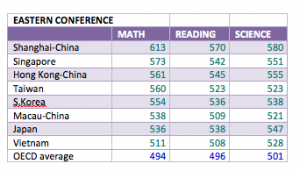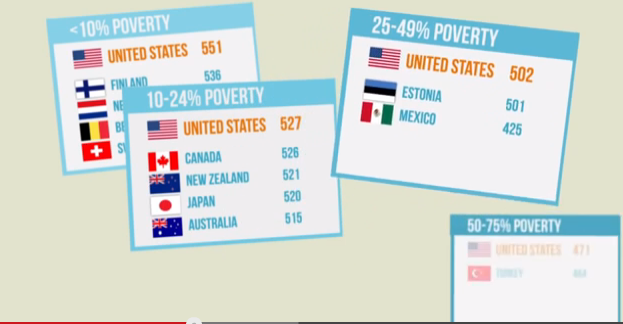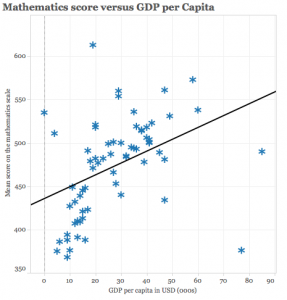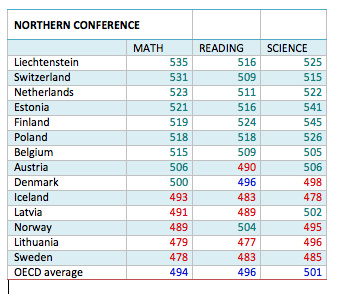Shanghai, Canada, Chile and Liechtenstein Head to the PISA Finals.
Suppose the PISA nations were organized into leagues and to follow the tradition of the sports world, a final competition would be held in February 2014, to coincide with the Winter Olympics in Russia.
Why these four countries? Shanghai is an obvious choice. Shanghai-China had the highest scores of all nations on maths (613), reading (570) and science (580). So, if there were going to be a “jeopardy” type finals based on the 2013 PISA scores, Shanghai-China would be seeded number one. But why the other three countries? Why Canada, Chile and Liechtenstein? None of these countries scored in the top dozen countries on PISA 2013. So, what’s going on here?
I organized the nations that participated in the PISA 2013 international test into four conferences. Using the well established method of the National Football League, Major League Baseball, and the National Basketball Association, four PISA conferences emerge as follows:
- Eastern Conference
- Western Conference
- Southern Conference
- Northern Conference
When the nations are organized into these four leagues, at the top of the leader board in each league are the following nations: Shanghai-China (Eastern), Canada (Western League), Chile (Southern League), and Liechtenstein (Northern League). Disclaimer: I did not include all the nations that participated in the PISA 2013. But those that I did include are clearly representative of each “conference”
Take a look at the league standings as organized into these four conferences. Does this organization tell us anything that we didn’t know before this filtering of the nations into these divisions?
Eastern Conference
 No surprises here, except when you dig deeper and ask why these countries do so well on international tests. All of these countries scored above the OECD average. According to Yong Zhao, we need to keep in mind that Asian education systems have always done well on international tests. Dr. Zhao is very skeptical of the Asian success on tests such as PISA because “they are very poisonous.” He reminds us that the Asian formula for success is based on four ideas: competition, standardization, frequent testing, and privatization. Indeed, these are the “symptoms” of the Global Education Reform Movement (GERM), which according to Pasi Sahlberg, are basic elements of reform in England and the United States. And according to Sahlberg, GERM has behaved like a virus, spreading around the world. We’ll see ahead, how GERM is spreading into the Southern Conference of nations.
No surprises here, except when you dig deeper and ask why these countries do so well on international tests. All of these countries scored above the OECD average. According to Yong Zhao, we need to keep in mind that Asian education systems have always done well on international tests. Dr. Zhao is very skeptical of the Asian success on tests such as PISA because “they are very poisonous.” He reminds us that the Asian formula for success is based on four ideas: competition, standardization, frequent testing, and privatization. Indeed, these are the “symptoms” of the Global Education Reform Movement (GERM), which according to Pasi Sahlberg, are basic elements of reform in England and the United States. And according to Sahlberg, GERM has behaved like a virus, spreading around the world. We’ll see ahead, how GERM is spreading into the Southern Conference of nations.
Western Conference
 The Western Conference includes nations from the “Western Hemisphere.” Four of the Western Conference nations scored above the OECD average in maths, reading, and science. The angst that appears every three years among these nations plays out in the newspaper, and when the secretary or commissioner of each nation’s education department speaks to the public. As some researchers have pointed out (Carnoy and Rothstein, 2013), the reasons countries do well or not so well are complicated. Much of the difference in scores can be attributed to non-school factors such family income, poverty level, books in the home, health care, and so forth. The difference between the top performing nation in the Western conference and lowest performing nation is 37 points (maths), 48 (reading), and 39 (science).
The Western Conference includes nations from the “Western Hemisphere.” Four of the Western Conference nations scored above the OECD average in maths, reading, and science. The angst that appears every three years among these nations plays out in the newspaper, and when the secretary or commissioner of each nation’s education department speaks to the public. As some researchers have pointed out (Carnoy and Rothstein, 2013), the reasons countries do well or not so well are complicated. Much of the difference in scores can be attributed to non-school factors such family income, poverty level, books in the home, health care, and so forth. The difference between the top performing nation in the Western conference and lowest performing nation is 37 points (maths), 48 (reading), and 39 (science).
As Carnoy and Rothstein (2013) point out, if countries like the U.S. had social class compositions similar to that of the leading nations on the PISA test, the U.S. would move up in the Western Conference almost to the top.
In fact as shown in this graphic, if PISA scores were reported on the basis of poverty level, e.g., less than 10%, or between 10 – 24%, or between 25 – 49%, the scores would look very different as shown in the graphic below.

Figure 1. Graphic from the AFT video, What Does the PISA Report Tell Us About U.S. Education. (http://bcove.me/emqcqfi7)
Southern Conference
If we look at nations in the Southern Conference, Chile leads the rankings. Although these countries scored below the OECD average, the same issues that face Western Conference nations apply to the Southern Conference. There is a need to give equitable education to all students. Reports on an analysis of PISA data, GDP per capita correlates with performance in mathematics. For example, nation’s whose GDP per capita ranged from $15,000 – $19,000 scored below the OECD average. Follow this link to an interactive graph showing these results as indicated below.

 Figure 2. Mathematics score versus GDP per Capita on 2013 PISA. Source: Sedghi, A, Arnett, G, and Chalabi, M. “Pisa 2012 results: which country does best at reading, maths, and science? The Guardian, December 3, 2013. http://www.theguardian.com/news/datablog/2013/dec/03/pisa-results-country-best-reading-maths-science
Figure 2. Mathematics score versus GDP per Capita on 2013 PISA. Source: Sedghi, A, Arnett, G, and Chalabi, M. “Pisa 2012 results: which country does best at reading, maths, and science? The Guardian, December 3, 2013. http://www.theguardian.com/news/datablog/2013/dec/03/pisa-results-country-best-reading-maths-science
Northern Conference
Northern Europe and Scandinavia include many nations that have traditionally done well on the PISA tests. However, if you were to read the headlines in newspapers of these countries, especially Finland, Norway and Sweden, you would think that the sky is falling. In the case of Finland, which has typically been at the top of the PISA charts, it fell a few places in the rankings. But many educators, such as Johann C. Fuhrmann, and Norbet Beckmann-Dierkes, explain how Finland has created an educational system that is NOT based on standards and high stakes testing, but on centering education on equity, health care, and teacher autonomy. These are characteristics that are in short supply around the world. Most countries believe that a central and standardized curriculum is in the best interests of all students. They also believe that accountability should be visible by means of market and corporate strategies, and that teachers should be evaluated by their students’ learning.

So, there you have it. A look at the PISA results through four lenses. Is it possible that we can learn more about education by examining the nature of schooling from different points of view, and through different cultures and situations. What do you think?





0 Comments